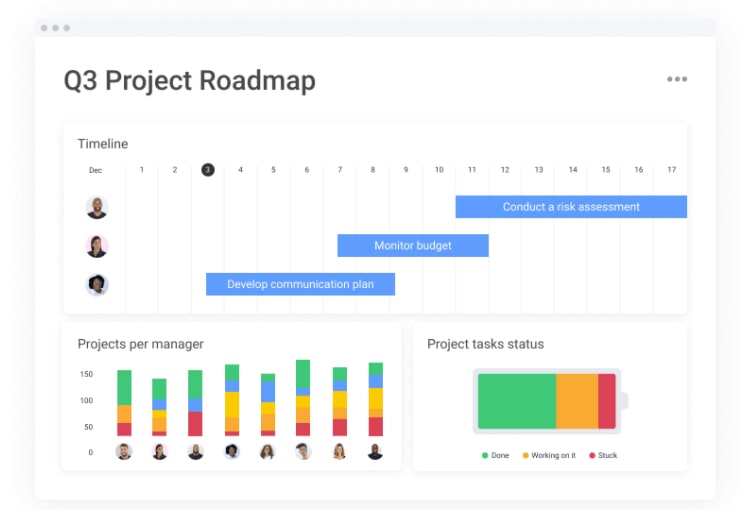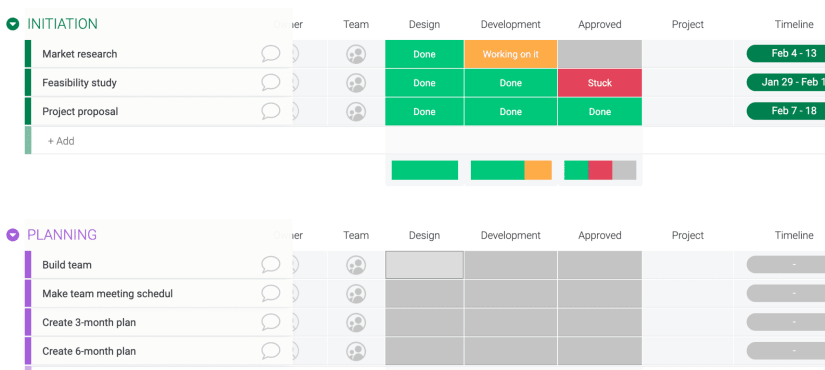As a business grows— signing clients, kicking off initiatives, developing new products—there are costs, deliverables, deadlines, and demands to manage.
This article will walk you through the ins and outs of the project management life cycle and provide a few tips on how to leverage project management software for flawless project execution. You’ll also discover a way to make all phases of project management lifecycle as smooth and transparent as possible.
Project management life cycle is part of our project management glossary. Head over to the glossary to learn more.
Before diving in though, let’s start at the very beginning.
What is the project management life cycle?
The project management life cycle describes each stage you move through as you create and execute a project. Starting with the project initiation phase, a project management life cycle moves through stages of planning, execution, control, and close.
It allows you to break your project into distinct parts that you can monitor, manage, and adjust as needed, such as planning which tasks need to be carried out by whom and when.
When you define your project management life cycle, project execution and task management becomes more streamlined because you’re able to set targets and see how effectively your time, resources, and budget are being used.
But without establishing a clear project life cycle, you could experience ‘scope creep’ — in which uncontrolled, unexpected variables creep into your project development and execution process.
The lifecycle takes place in 5 phases: initiation, planning, execution, and closeout. Each phase includes steps that upon completion will feed into the next.
The 5 Project Management Phases
PHASE 1: Project Initiation
PHASE 2: Project Planning
PHASE 3: Project Execution
PHASE 4: Project Monitoring and Control
PHASE 4: Project Close-out
Phase One: Initiation
Every well managed project starts with analysis, discussion, and decision-making. This is initiation.
The Project Initiation phase is where you identify a business need or problem and a potential solution. Oftentimes, teams use a checklist made up of project initiation activities and project initiation deliverables (which we’ll cover more in the bullets below).
When working through the checklist, you’ll analyze what you’ll need to execute the solution and how to get leadership on board.
Let’s say the Order Processing department of Company X is experiencing major performance issues due to the design process of their order management tool. They have asked for some changes that will decrease call time and improve the customer experience. Your project team has a solution and needs approval to launch this development project, so the initiation phase begins. You will:
- Conduct a feasibility study – this defines the existing problem and determine whether the project will solve it.
- Identify the project scope – understand how long and demanding will it be and what kind of impact will it have on the business.
- Define project deliverables – describe the product or service that the project team will provide.
- Identify your project stakeholders – they are the ones with the most skin in the game. Knowing their priorities will help you set your own.
- Create the business case that justifies the need for the project based on the cost and resource demand.
- Write a Statement of Work (SOW) – this is for clients to understand the activities that will be performed, the time commitment and the deliverables.
Once the initiation phase is completed and the decision makers have greenlit your project, it is time to start mapping out the project details in the next phase: Planning.
Read also: Creating a Project Initiation Document
Phase Two: Planning
The Project Planning phase is where the work that you described during initiation gets broken into smaller, manageable chunks. In this phase, you will define specific tasks, assign responsibilities, and create the project schedule. Here is what you’ll do:
- Design the project plan and timeline – document project milestones, deadlines and deliverables. Create a workflow or process map for a visual representation of the entire project.
- Create the budget – this is a deeper breakdown of how funds will be allocated, including resource costs, tools, and any other expenses that should be billed to the project.
- Choose your resources and assemble your team – look at the project’s deliverables and choose (or hire if the budget allows) the best possible people for each task.
- Once the team is formed, hold a kickoff meeting – you will share the details from the project plan and budget and get everyone aligned on the project goals.
Its looking pretty good at this point – your project is approved, you’ve built your team, and the plan is perfectly mapped out. Now it’s time to spring into action in the next phase: Execution.
Phase Three: Execution
The Execution phase is where the true project management work happens. This may take up the most amount of time in the project management life cycle. You will be touching base with resources, watching the timeline and budget, and reporting back to stakeholders. You need to be ready to make adjustments and put out fires.
For example, If one of your developers turns out to be slower than you expected, you are losing money on that resource and will need to make a personnel change or reprioritize their deliverables. That same flexibility will be needed to adjust the scope, budget or schedule as needed. Your steps include:
- Hold weekly team meetings – you will ask for task updates from the team. Encourage collaboration by asking for input. Listen to issues and offer solutions to overcome roadblocks.
- Meet with individual resources – track progress and monitor the quality of their performance. You can talk through any issues or project management challenge you or they prefer to address privately.
- Conduct team-building activities – support morale and encourage communication.
- Release regular communications – weekly emails providing project updates are a great way to keep everyone on the same page and set expectations for the next stage. Create weekly update messages that are internal to the project team and broader messages that can be distributed company-wide.
So now your project is in full swing – and it’s up to you to make sure it stays as close to that beautiful plan you created. The Controlling phase is where that happens.
Phase Four: Monitoring and Controlling.
While ‘Monitoring and Controlling’ is discussed separately from the ‘Execution’ phase, it makes sense to run the two in parallel. Running these two phases side-by-side gives the opportunity to check, at any given moment, where the project is currently in comparison to where it should be.

And this isn’t just about whether things are being delivered according to schedule or that quality meets your standards.
It’s checking that the project isn’t experiencing “scope creep” and delivering something that wasn’t originally defined. It’s also an opportunity to check how much money is left in the project bank and whether you need to tighten the purse strings.
*Note — the scope of projects does change and that should be expected. Just make sure you have a change control process and formally capture how the requirements are now different.
Phase Five: Closeout
The Closeout phase is where you review the experience to determine the success of the project. This is not only critical for demonstrating the value of the project to stakeholders and clients, but it gives you a roadmap for the future. Here’s what you’ll do:
- Document project completion, checking off all deliverables and their status
- Hold a post-mortem meeting to review everything that happened during the project. Ask for input on what went well, what should be improved and what should never happen again.
- Analyze the performance of each resource and the team as a whole. Use the post mortem meeting to congratulate the team, and recognize people for their accomplishments and contributions.
- Create a project review and lessons learned report that includes what came out of that meeting.
- Do a final budget review to identify where the budget was met and where it was strained
So the project is complete, and now you know how to move from beginning to end with structure and organization. The project management lifecycle is a reliable strategy for setting standards and avoiding repeat mistakes, but there’s another way to make sure all you cross all of your “t’s” and dot your “i’s.”
How to enhance your project management life cycle with software
For your project to be successful, you need your project management life cycle to be collaborative, transparent, and (just as importantly) make sense.
On Work OS like monday.com, you can streamline the project management life cycle so you fly through each phase without blowing the budget or missing your deadlines.
Not sure where to start? The monday.com project management templates can help you explore ideas in an organized way and propose projects in a visually-appealing way to decision-makers. For instance, our Project Proposal template enables you to map out the scope of the issue, the goals of your project, and the viability of your solution.

Fill in the template with your findings by adding notes and files, and assign tasks to your team to get answers to your questions. Collaborators can check updates and monitor the activity log while viewing progress in the status bar of each task.
But for high-leveling planning, think big.

On the monday.com High-Level Project Plan template, you can get a broad overview of the project’s phases and the steps that need to be done at each stage. Assign team members steps in each phase so they can flesh out the tasks that need to be completed as you move through the project’s life cycle.
Templates can also help enhance collaboration on project management documentation.
In fact, Work OS’s have been shown to increase collaboration by 51% (and we’ve definitely seen that with our own customers).
Using monday.com as an omnichannel solution for project documentation, you can collate all files into one neat place.
Organize your documentation into each phase of the project life cycle so you can better find files for future reference.
Upload files into the tasks and assign senior team members to approve all documentation. Update approval statuses so it’s immediately obvious which documents are still in the pipeline.
Keeping all documentation in one place makes the closing phase of your project management life cycle far easier. You’ll be able to see what’s missing to chase documentation, and you’ll be able to refer back when replicating projects in the future. A basic overview of project steps is also important for stakeholders to understand what you’ll accomplish and how.
What else is needed to run successful projects?
As you gain more experience managing projects, you will want to offer your stakeholders and clients even greater assurance of quality. Strategizing and Maintenance are bookend phases, taking place at the beginning and end of the project.
Strategizing actually happens pre-project, and usually takes place without the project manager. But including the PM in those discussions increases the potential of the project being aligned with business goals and objectives. Attend meetings, document the outcomes of those meetings and use those to define the project scope, set deliverables and develop the timeline.
Maintenance takes place after the project has been completed. It is a check in to see how the product or service is performing, and to assess customer satisfaction. This serves many purposes – it can preemptively address problems, resolve issues, inform future projects, and identify future opportunities.
Take control of the project life cycle
You don’t need to reinvent the wheel when it comes to creating a project management life cycle that works for you.
Instead, build off an omnichannel platform like monday.com. Our templates and software offers the ideal solution for planning, executing, and monitoring the life cycle of any project of any size across all your departments.


